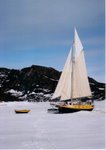Going S from Banks Peninsula and its many
harbours (the biggest being Akaroa - translated from
Maori as 'Long Harbour'), you can count the decent
havens on just a few fingers: Timaru (rather
industrial), Oamaru (utterly not recommended unless
you have excellent and up-to-date local knowledge),
Dunedin, the Nuggets (a peninsula one can shelter
behind), Waikawa (entrance as per Oamaru), perhaps
Tautuku, and certainly Bluff . Bluff can have
serious tides, as the entrance drains a large
estuary. Call Mary on VHF channel 61 or 63 to get up
to the minute recommendations. Hey, even (maybe even
mostly) the fishermen check in. It is the smart
thing to do. Once out of the shipping channels one
can go lots of places to anchor, though with three
metre (10 ft) tides (as I experienced) make sure you
have clear water at low tide.
Bluff is famous for being both the furthest S
one can go on 'mainland' NZ (which is actually Slope
Pt, a few miles to the E) and for its seafood,
especially its oysters. Blue cod, crayfish and paua
(abalone near relative) are most often available,
and the oysters during their own somewhat short
season. If you like oysters and happen to be in
Bluff when it is season, then don't be shy. All of
NZ eagerly awaits the oyster season, and the smart
eaters move fast. Bluff is also a good place to get
repairs done, and avail one's self of safety gear
(life raft, epirb, &c) because this is where the
fishermen get theirs.
If one goes S from Bluff, then Rakiura/Stewart
Island is the next port of call. Get the latest
Foveaux Strait conditions and weather from
Fisherman's Radio before you cross the Strait, as
conditions can change for the seriously worse almost
instantly. One can also get flat calm conditions, as
we did last time we went there. Even Cape Horn must
have calms, one imagines. Stewart Island's waters
are strewn with rocks; navigators pay attention! The
nearest harbour/port/anchorage is Half Moon Bay,
which sits before the settlement of Oban. Halfmoon
Bay is protected from anything except a screaming
NW'ly. Most things are available here, often not
cheaply since transport is not inexpensive. In a
small settlement such as Oban there are many
'the's', the foodstore, the pub, the wharf, &c.
Yes, one can get lucky and tie up briefly to the
wharf for taking on crew/passengers or water, but
ask at the ferry dock first. At the 4 Square variety
market one can obtain food, wine and beer (at
surprisingly affordable prices) and other
often-requested supplies. Both diesel and petrol and
LPG are available at the petrol station. It seems
that the only negatives are the prices... and the
sandflies. The locals say that you get used to them
(the flies), but I always return from Stewart Island
with weeping bites where I scratched. Distances
around Oban are short, so you can walk from one end
of the town to the other in an easy pace. Don't let
that fool you though, because Stewart Island is a
big place; most of it in National Park. Close around
the corner going E is Paterson Inlet, big enough to
get rough conditions, but big enough also to have
numerous nooks and crannies. I can recommend Kaipipi
Bay (almost landlocked) for good shelter at the end
of a narrow entrance and having nice, heavy mud.
Dunedin has a wonderful harbour, the Otago
Harbour, that it sits at the head of. The harbour
offers excellent refuge from winds and seas of any
direction, though getting through the narrow and
somewhat winding entrance in a wind against tide
situation can be a bit rough. The bays offering the
best shelter are Portobello Bay (to the N of the
hamlet of Portobello, which is on the S side of the
Portobello peninsula), Latham Bay (directly at
Portobello) and Broad Bay (still on the E side but
another nautical mile further along).
The trouble with the Otago Harbour is that it is
tidal and shallow. At half to or after high water
any boat with 2m or less should have no trouble at
all... in the natural channels. Consult your chart
and depth sounder fairly often, though if you do run
aground most of the harbour is mud and sand so there
is generally nothing more than pride affected. This
is NOT the case with the main (W-side ship) channel
which is lined with rocks, beginning on its E side
where the middle ground cut/channel (from Kilgour Pt
to Grassy Pt) is.
Do remember that Dunedin is near enough to 46
degrees South latitude, hence it is often cold here.
We do get warm and even hot temperatures, but
Barbados it isn't. One nice thing about a higher
latitude is the long light one may have before
darkness. At summer's solstice one can still read
the paper outside at 2200.
Dunedin was Aotearoa NZ's big city in the latter
half of the 19th century, mainly due to the
discovery of gold nearby in 1863 (+/-); and it
remains an important center of urban life, supply
and repair. The visitor's center in the Octagon
(center of the city) is helpful for general &
tourist information. For boat oriented things it
would probably be a good idea to contact Read Marine
(ph (03) 474 0871), who either have what you are
looking for or can direct you in your search.



No comments:
Post a Comment